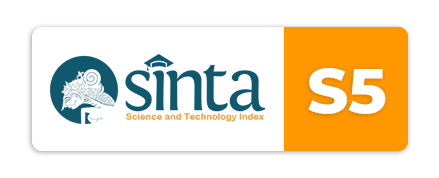DICOM Image Analysis for Lung Cancer Detection Using Convolutional Neural Network (CNN)
DOI:
https://doi.org/10.31004/jestm.v5i2.290Keywords:
Lung cancer, CT Scan, DICOM, Deep Learning, Convolutional Neural Network (CNN)Abstract
Lung cancer remains the leading cause of cancer-related deaths worldwide, with the highest burden in Asia, including Indonesia. Early detection is critical, yet access to radiology services is often limited by infrastructure, cost, and a shortage of trained specialists. Recent advances in artificial intelligence, particularly Convolutional Neural Networks (CNNs), offer promising solutions for automated image-based diagnosis. This study aims to analyze the effectiveness of CNN in detecting lung cancer from CT scan images in DICOM format. A dataset consisting of lung CT images from Kaggle and local hospitals was preprocessed through Gaussian blur filtering, segmentation, and pixel normalization before model training. Images were classified into two categories: cancer and non-cancer. The CNN architecture was trained and validated with an 80:20 split ratio, and model performance was assessed using accuracy, precision, recall, and F1-score. The experimental results show that the proposed CNN model achieved an accuracy of 88.27%, precision of 88.96%, recall of 97.43%, and an F1-score of 92.98%. The high recall value indicates the model’s strong ability to minimize false negatives, which is essential for clinical application. Performance graphs demonstrated stable accuracy and loss across training and validation sets, suggesting minimal overfitting.In conclusion, the developed CNN model demonstrates strong potential as a supportive diagnostic tool for early lung cancer detection, particularly in resource-limited healthcare settings. Its integration into radiology workflows may accelerate screening processes and improve clinical decision-making
References
Adnan, Suhartini, & Kusbiantoro, B. (2013). Identification of Rice Varieties Based on Color and Surface Texture Using Digital Image Processing and Artificial Neural Networks. Food Crop Agricultural Research, 32(2), 91–97.
Alfarizi, MRS, Al-farish, MZ, Taufiqurrahman, M., Ardiansah, G., & Elgar, M. (2023). Using Python as a Programming Language for Machine Learning and Deep Learning. Scientific Work of Tauhid Students (Karimah Tauhid), 2(1), 1–6.
Alfath Daryl Alhajir, Yisti Vita Via, & Wahyu Syaifullah Jauharis Saputra. (2021). Rice Object and Foreign Object Detection System Based on Keras and Google Colab. Journal of Informatics and Information Systems, 2(3), 580–586. https://doi.org/10.33005/jifosi.v2i3.369
Ardila, D., Kiraly, A.P., Bharadwaj, S., Choi, B., Reicher, J.J., Peng, L., Tse, D., Etemadi, M., Ye, W., Corrado, G., & Naidich, D.P. (2018). End-to-end lung cancer screening with three-dimensional deep learning on low-dose chest computed tomography. Nature Medicine. https://doi.org/10.1038/s41591-019-0447-x
Brawijaya, U., Rachmatika, IS, Muflikhah, L., & Setiawan, BD (2017). Faculty of Computer Science: Detecting Mutations in Lung Cancer Through CT-Scan Images: Application of Convolutional Neural Networks (CNN) Algorithm Model and Adam Optimizer. 1(1), 2548–2964. http://j-ptiik.ub.ac.id
Dartiko, F., Pradana, RJ, Sari, RE, Syahputra, W., & Oktoeberza, WK (2024). CNN-Based Skin Cancer Classification with Hybrid Preprocessing Method. Medika Teknika: Indonesian Journal of Electromedical Engineering, 5(2), 124–132.https://doi.org/10.18196/mt.v5i2.22675
Fadli, C., & Desmulyati, D. (2021). Implementation of Face Detection Calculation Using the Haar Cascade Classifier Method. National Journal of Computing and Information Technology (JNKTI), 4(6), 535–542. https://doi.org/10.32672/jnkti.v4i6.3721
Febriani, A., & Furqon, A. (2020). Lung Cancer Metastasis. Journal of Respiration, 4(3), 94. https://doi.org/10.20473/jr.v4-i.3.2018.94-101
Hernández-rodríguez, J. (2022). Convolutional Neural Networks for Multi-scale Lung Nodule Classification in CT : Influence of Hyperparameter Tuning on Performance. 11(1), 297–306. https://doi.org/10.18421/TEM111
I Komang Setia Buana. (2020). Implementation of a Speech to Text Application to Make it Easier for Journalists to Record Interviews with Python. Journal of Systems and Informatics (JSI), 14(2), 135–142. https://doi.org/10.30864/jsi.v14i2.293
Ilham, F., & Rochmawati, N. (2020). Transliteration of Handwritten Javanese Script into Latin Script Using CNN. Journal of Informatics and Computer Science (JINACS), 1(04), 200–208. https://doi.org/10.26740/jinacs.v1n04.p200-208
Mastouri, R. (2020). A bilinear convolutional neural network for lung nodules classification on CT images. Dl.
Meaden, C.W., Kashani, J.S., & Vetrano, S. (2019). Pulmonary Edema Occurring after Nitric Acid Exposure. Case Reports in Emergency Medicine, 2019(1), 1–4. https://doi.org/10.1155/2019/9303170
Mulyawan, H., Samsono, MZH, & Setiawardhana. (2011). Image-Based Object Identification and Tracking. Real-Time Image Processing-Based Object Identification and Tracking, 1–5. http://repo.pens.ac.id/1324/1/Paper_TA_MBAH.pdf
Munandar, A. (2020). Programming language. THEMATICS | Technology Management and Informatics Research Journals TEMATICS | Technology Management and Informatics Research Journals, 4(2), 12.
Nasha Hikmatia AE, & Zul, MI (2021). An Android-based Indonesian Sign Language to Speech Translator Application using Tensorflow. Applied Computer Journal, 7(1), 74–83. https://doi.org/10.35143/jkt.v7i1.4629
Phiadelvira, BY (2021). Classification of cervical cancer based on colposcopy images using the Convolutional Neural Network (CNN) Alexnet Model. In JIKO (Jurnal Informatika dan Komputer) (Vol. 4, Issue 1).
Adnan, Suhartini, & Kusbiantoro, B. (2013). Identification of Rice Varieties Based on Color and Surface Texture Using Digital Image Processing and Artificial Neural Networks. Food Crop Agricultural Research, 32(2), 91–97.
Alfarizi, MRS, Al-farish, MZ, Taufiqurrahman, M., Ardiansah, G., & Elgar, M. (2023). Using Python as a Programming Language for Machine Learning and Deep Learning. Scientific Work of Tauhid Students (Karimah Tauhid), 2(1), 1–6.
Alfath Daryl Alhajir, Yisti Vita Via, & Wahyu Syaifullah Jauharis Saputra. (2021). Rice Object and Foreign Object Detection System Based on Keras and Google Colab. Journal of Informatics and Information Systems, 2(3), 580–586. https://doi.org/10.33005/jifosi.v2i3.369
Ardila, D., Kiraly, A.P., Bharadwaj, S., Choi, B., Reicher, J.J., Peng, L., Tse, D., Etemadi, M., Ye, W., Corrado, G., & Naidich, D.P. (2018). End-to-end lung cancer screening with three-dimensional deep learning on low-dose chest computed tomography. Nature Medicine. https://doi.org/10.1038/s41591-019-0447-x
Brawijaya, U., Rachmatika, IS, Muflikhah, L., & Setiawan, BD (2017). Faculty of Computer Science: Detecting Mutations in Lung Cancer Through CT-Scan Images: Application of Convolutional Neural Networks (CNN) Algorithm Model and Adam Optimizer. 1(1), 2548–2964. http://j-ptiik.ub.ac.id
Dartiko, F., Pradana, RJ, Sari, RE, Syahputra, W., & Oktoeberza, WK (2024). CNN-Based Skin Cancer Classification with Hybrid Preprocessing Method. Medika Teknika: Indonesian Journal of Electromedical Engineering, 5(2), 124–132. https://doi.org/10.18196/mt.v5i2.22675
Fadli, C., & Desmulyati, D. (2021). Implementation of Face Detection Calculation Using the Haar Cascade Classifier Method. National Journal of Computing and Information Technology (JNKTI), 4(6), 535–542. https://doi.org/10.32672/jnkti.v4i6.3721
Febriani, A., & Furqon, A. (2020). Lung Cancer Metastasis. Journal of Respiration, 4(3), 94. https://doi.org/10.20473/jr.v4-i.3.2018.94-101
Hernández-rodríguez, J. (2022). Convolutional Neural Networks for Multi-scale Lung Nodule Classification in CT : Influence of Hyperparameter Tuning on Performance. 11(1), 297–306. https://doi.org/10.18421/TEM111
I Komang Setia Buana. (2020). Implementation of a Speech to Text Application to Make it Easier for Journalists to Record Interviews with Python. Journal of Systems and Informatics (JSI), 14(2), 135–142. https://doi.org/10.30864/jsi.v14i2.293
Ilham, F., & Rochmawati, N. (2020). Transliteration of Handwritten Javanese Script into Latin Script Using CNN. Journal of Informatics and Computer Science (JINACS), 1(04), 200–208. https://doi.org/10.26740/jinacs.v1n04.p200-208
Mastouri, R. (2020). A bilinear convolutional neural network for lung nodules classification on CT images. Dl.
Meaden, C.W., Kashani, J.S., & Vetrano, S. (2019). Pulmonary Edema Occurring after Nitric Acid Exposure. Case Reports in Emergency Medicine, 2019(1), 1–4. https://doi.org/10.1155/2019/9303170
Mulyawan, H., Samsono, MZH, & Setiawardhana. (2011). Image-Based Object Identification and Tracking. Real-Time Image Processing-Based Object Identification and Tracking, 1–5. http://repo.pens.ac.id/1324/1/Paper_TA_MBAH.pdf
Munandar, A. (2020). Programming language. THEMATICS | Technology Management and Informatics Research Journals TEMATICS | Technology Management and Informatics Research Journals, 4(2), 12.
Nasha Hikmatia AE, & Zul, MI (2021). An Android-based Indonesian Sign Language to Speech Translator Application using Tensorflow. Applied Computer Journal, 7(1), 74–83. https://doi.org/10.35143/jkt.v7i1.4629
Phiadelvira, BY (2021). Classification of cervical cancer based on colposcopy images using the Convolutional Neural Network (CNN) Alexnet Model. In JIKO (Jurnal Informatika dan Komputer) (Vol. 4, Issue 1).
Sasikala, S., Bharathi, M., & Sowmiya, B. R. (2018). Lung Cancer Detection and Classification Using Deep CNN. 2, 259–262.
Setiawan, H., Utami, E., & Al Fatta, H. (2020). Application of Arima and Artificial Neural Networks to Predict Dengue Fever Patients in Sragen Regency. Jogja Maritime Scientific Magazine, 18(2), 64–78. https://doi.org/10.33489/mibj.v18i2.220
Sung, H., Ferlay, J., Siegel, R.L., Laversanne, M., Soerjomataram, I., Jemal, A., & Bray, F. (2021). Global Cancer Statistics 2020 : GLOBOCAN Estimates of Incidence and Mortality Worldwide for 36 Cancers in 185 Countries. 71(3), 209–249. https://doi.org/10.3322/caac.21660
Wirawan, S., Wayan, ) I, Wicaksana, S., Guritno, S., & Harjoko, A. (2005). Embedded XML Data in Images with SVG Format for Medical Image Representation. National Seminar on Information Technology. http://www.w3.org/Graphics/SVG/1.1/DTD/svg11.dtd
Yuliani, S., Lubis, LE, Nurlely, N., & Soejoko, DS (2018). Quantitation and analysis of computed radiography images in paranasal sinus examinations of pediatric patients using the line profile method. Journal of Medical Physics and Biophysics, 5(1), 139–154. http://jmpb.org/index.php/jmpb/article/view/316
Downloads
Published
How to Cite
Issue
Section
License
Copyright (c) 2025 M. Arib Insanul Kamil, Romi Mulyadi

This work is licensed under a Creative Commons Attribution-ShareAlike 4.0 International License.









